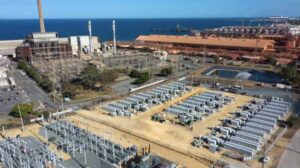As we absorb the hysterical claims – in the ABC, Fairfax, the Murdoch media and commercial TV – about the prospect of imminent power shortages, let’s just cast our eyes back just two and a half years when the fossil fuel industry was predicting …. wait for it …. an unprecedented supply glut.
According to the Australian Energy Market Operator at the time, there would be no need for any new generation for up to 10 years in south-eastern Australia, because of what was then described as that “unprecedented glut”.
“What we’re saying is that is that there’s an oversupply of generation capacity at present,” an AEMO spokesman, Joe Adamo, told the ABC at the time. And you can see that from those forecasts there.
The fossil fuel industry and big business seized on those forecasts to argue forcefully that the renewable energy target should be heavily cut, if not scrapped.
The Abbott government needed no encouragement, and despite being foiled by the Senate in its attempts to kill it entirely, it did succeed in cutting the RET, and sparking an investment drought that lasted from 2013 until the end of last year.
As Alan Pears and David Leitch each wrote in separate pieces on Thursday, Australian consumers and businesses are now paying the price for that act of policy vandalism, and the huge delays in investment in renewable energy that occurred thanks to the Abbott government.
Leitch puts the extra cost – in terms of wholesale electricity prices – at more than $11 billion. And soon enough, that will filter through to retail costs, already surging out of control according to a recent study by the Grattan Institute (and many others).
(Although in delightful irony, the former head of Hazelwood, Tony Concannon, noted this week that the Coalition’s canning of the carbon price and its slashing of the RET also killed any chance of investment in new coal plants, because no investor would every trust a government again on climate policies).
Fast forward to now, and even though there has been no increase in demand, the fossil fuel industry is revelling in unprecedented profits, as spot and future price soar across the nation – particularly in the coal states.
Because of the lack of competition that could have been introduced if the RET policy was held steady, the incumbent generators can now use their market power to artificially inflate prices, and somehow convince mainstream media and conservative politicians that it is all the fault of wind and solar.
“It looks like the generators succeeded, as expected, in delaying investment until they could enjoy a price bonanza as they withdraw faster than replacement can get underway now,” says one senior executive, who declined to be named.
Spark Infrastructure, which runs two of the three networks in Victoria, and the only network in South Australia, was not so shy, writing in its submission to the Finkel Review that fossil fuel generators were deliberately dealing in “scarcity” to push up prices.
They did this, it said, by deliberately withdrawing capacity at critical times.
Now, absurdly, ex-prime minister Abbott has come out to call for government subsidies to ensure that the Hazelwood power station does not shut next week as planned, but stays open.
Equally absurdly, this call was repeated by, of all people, Innes Willox, the head of the business lobby group Australian Industry Group, who on the ABC repeated the nonsense written on the front page of The Age on Thursday, which claimed – erroneously – that the market operator is now forecasting 10 weeks of energy supply shortages over the next two summers.
We explained here why that was rubbish. But we do understand why Willox – in his more moderate remarks circulated to the media a day earlier – no longer has faith in the markets. He described the possibility of generators doing the right thing and delivering supply as a “big if”.
It’s not because they can’t, but because they might not choose to. They might, as South Australia premier Jay Weatherill described it, choose to put “profits before people” and not deliver the needed supply at all.
And the fossil fuel generators are still piling in. A number of them – such as ERM – are calling for “capacity payments”, effectively another sort of subsidy payment to ensure that they do not close.
Having, as Spark pointed out, artificially pushed up prices by making capacity scarce, they are now threatening to withdraw capacity unless the regulators authorise a new payment. It is extraordinary.
The South Australian government, to its credit, has decided to try and tackle this nonsense by introducing an “energy supply target”, which seems deliberately calibrated to ensure that the fossil fuel industry does not shut down more capacity, and create more scarcity.
The Weatherill government is still reeling from the decision by the Pelican Point not to switch on its second unit and watch while its own customers, and tens of thousands of others, were blacked out. Weatherill is building an emergency back-up to ensure that such “market failures” are not repeated.
In many ways, the fossil fuel industry is replicating the artificial shortage it has created in the gas market, and then demanded special dispensations – in the form of access to CSG fields and subsidies – to guarantee supply.
This market rorting, however, does not just apply just to the supply of gas and electricity, but also to “grid services”, the supply of frequency and ancillary benefits, of the FCAS market – as the AER outlined in great detail in its report here:
“The incumbent generators have not just succeeded in delaying the construction of wind and solar farms for as long as they can …. and fighting energy efficiency initiatives …. they have also convinced regulators to make it as difficult as possible for new technologies such as battery storage and demand management to enter the industry.”
One proposal seen as critical to this transition is the so-called 30-minute rule, which means that while market bids are made every 5 minutes, the settlement is made every 30 minutes on an average of the six five minute bids in that period.
Everyone, including AEMO, admits this results in distortions, and that means higher prices and not lower prices. It favours slow and clunky gas fired generators.
The pattern is clear, Sun Metals and the Melbourne Energy Institute and others have pointed out – capacity suddenly becomes scarce in the first five minute period, prices shoot up, and having guaranteed a windfall gain for the 30 minute period, capacity suddenly becomes “available” again and swamps the market.
Switching to a 5 minute settlement would allow fast response battery storage to respond in 5 minute periods. But the fossil fuel industry doesn’t want a bar of it, and has threatened, once again, to withdraw capacity if it goes ahead.
Who’s going to stop them? Not the regulators – they don’t seem interested. The competition czar, Rod Simms, thinks it is all a wonderful example of a market at work.
And not the rule makers either, at least not any time soon. The Australian Energy Market Commission is still pondering its already twice delayed review of the 30 minute rule, and on Thursday it called for submissions for the design of a new FCAS market.
But the way it did so was quite extraordinary.
It was written, noted one battery storage proponent, “from a presumption that traditional synchronous generation is the path to stability … it allows the possibility that batteries and other non-synchronous generation might be able to do the job, but almost as an after-thought.”
There is a belief in the renewables industry that too many within the energy bureaucracy simply don’t understand what is happening around them. The apparent weak settings on incumbent generators, highlighted by several new reports, including this one, is a case in point.
One hope is that the Finkel Review will be able to cut through. Finkel, in his draft report, understood that the technologies to address the issues created by the transition to a decarbonised grid are there, but the rules that would allow that to happen – and relax the stranglehold of the fossil fuel incumbents – are not there.
This was the point underpinned not just by Spark Infrastructure, but the entire network industry. They fear that their future is put at risk by the untrammelled gamesmanship of the fossil fuel industry.
They point out that if the vested interests are not swept aside, and the rules are not changed, then consumers will simply take matters into their now hands and look after their own technology needs.
They now have the technologies to do that, and with every passing month, the cost of such action falls further beneath the soaring cost of the archaic market designed for another century.










